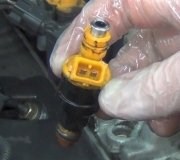Good afternoon,
I attached a TSB on this for the canister having a blockage in it not allowing air to release when fueling.
https://www.2carpros.com/articles/how-emission-control-systems-work
It most likely is the front canister.
Roy
NUMBER: 14-001-09 REV. A
GROUP: Fuel
DATE: September 1, 2009
This bulletin supersedes technical service bulletin 14-001-09, dated april 15, 2009, which should be removed from your files. This is a complete revision and no asterisks have been used to highlight revisions.
SUBJECT:
Hard To Fill With Fuel Or Fuel Nozzle Shuts Off Repeatedly
MODELS:
2004-2008 (CS) Pacifica 2009 (DS) Ram Truck (1500) 2007 - 2009 (DH) Ram Truck (1500/2500 Pick Up) 2004 - 2009 (DR) Ram Truck (1500 / 2500 Pick Up) 2005 - 2009 (HB) Durango 2007-2009 (HG) Aspen 2005 - 2009 (ND) Dakota 2009 (JC) Journey 2007 - 2009 (JK) Wrangler 2007 - 2009 (J1) Sebring (China CKD) 2007 - 2009 (JS) Sebring/Sebring Convertible/Avenger 2006 - 2009 (K1) Cherokee (CKD) 2007 - 2009 (KA) Nitro 2008 - 2009 (KK) Liberty 2008 - 2009 (KK) Cherokee (International Markets) 2005-2007 (KJ) Liberty 2005 - 2007 (KJ) Cherokee (International Markets) 2005 - 2009 (LE) 300C/300C Touring (International Markets) 2005 - 2009 (LX) 300/Magnum/Charger 2007 (L2) 300 (China) 2008 - 2009 (LC) Challenger 2004 - 2009 (PT) Chrysler PT Cruiser 2007 (R2) Caravan/Voyager(CKD) 2005 - 2007 (RG) Chrysler Voyager (International Markets) 2003 - 2007 (RS) Town & Country/Caravan/Voyager 2008 - 2009 (RI) Town & Country/Grand Caravan 2008 - 2009 (RI) Town & Country/Grand Voyager (International Markets) 2005 - 2006 (TJ) Wrangler 2005 - 2009 (WH) Grand Cherokee (International Markets) 2005 - 2009 (WK) Grand Cherokee 2006 - 2009 (XH) Commander (International Markets) 2006 - 2009 (XK) Commander
NOTE:
This bulletin applies to all vehicles equipped with a gasoline engine.
DISCUSSION:
Customer may report that the vehicle is hard to fill with fuel or that the fuel pump nozzle shuts off repeatedly while trying to fill vehicle.
This customer complaint can occur due to a number of different causes. The fuel tank is the least likely cause of this condition. The following Diagnostic procedure can be used to diagnose the issues.
DIAGNOSIS:
1.Is the vehicle a LX/LE/LC/L2?
a. Yes >> proceed to Step # 2
b. No >> proceed to Step # 4
2.Idle the vehicle 60 to 90 seconds upon stopping.
3.Does tank refill properly?
a. No >> proceed to Step # 4
b. Yes >> Inform the customer to idle the vehicle for 60 to 90 seconds upon stopping if vehicle was driven aggressively. This is due to the fact that on the LX/LE/LC/L2 the fuel tank is a unique saddle tank design and needs 30 to 60 seconds while the engine is running to level the fuel in both half's of the fuel tank. Allowing the vehicle to idle for this amount of time will let the fuel pump transfer fuel to the left side tank, opening the control valve and allowing normal fuel filling.
4.Disconnect the vapor recirculation tube at the fuel tank.
5.Attempt to refill fuel tank.
6.Does tank refill properly?
a. Yes >> Proceed to Step # 7
b. No >> Proceed to Step # 11.
7.Reconnect the vapor recirculation tube at the fuel tank.
8.Disconnect the other end of the vapor recirculation tube at the fuel filler tube.
9.Attempt to refill fuel tank.
10.Does tank refill properly?
a. Yes >> Replace fuel filler tube.
b. No >> Replace the vapor recirculation tube.
11.Disconnect the control valve to EVAP canister tube at the fuel tank.
12.Reconnect the vapor recirculation tube at the fuel tank.
13.Does tank refill properly?
a. No >> Replace Fuel Tank.
b. Yes >> Proceed to
14.Reconnect the control valve to EVAP canister tube at the fuel tank.
15.Disconnect the control valve to EVAP canister tube at the EVAP canister.
16.Attempt to refill fuel tank.
17.Does tank refill properly?
a. Yes >> Blockage is in the EVAP Canister, or ESIM, or Clean air hose (ESIM vent hose), or filter. Diagnose appropriately.
b. No >> Replace the control valve to EVAP canister tube.
POLICY:
Information Only
Disclaimer:
This bulletin is supplied as technical information only and is not an authorization for repair.
There are 2 EVAP canisters on the vehicle. The vacuum and vapor tubes connect to the top of the canister. It is a charcoal canister.
All vehicles use a maintenance free, evaporative (EVAP) canister. Fuel tank vapors vent into the canister. The canister temporarily holds the fuel vapors until intake manifold vacuum draws them into the combustion chamber. The Powertrain Control Module (PCM) purges the canister through the proportional purge solenoid. The PCM purges the canister at predetermined intervals and engine conditions.
Purge Free Cells
Purge-free memory cells are used to identify the fuel vapor content of the evaporative canister. Since the evaporative canister is not purged 100% of the time, the PCM stores information about the evaporative canister s vapor content in a memory cell.
The purge-free cells are constructed similar to certain purge-normal cells. The purge-free cells can be monitored by the DRB III(R) Scan Tool. The only difference between the purge-free cells and normal adaptive cells is that in purge-free, the purge is completely turned off. This gives the PCM the ability to compare purge and purge-free operation.
Images (Click to make bigger)
Tuesday, February 2nd, 2021 AT 1:05 PM






